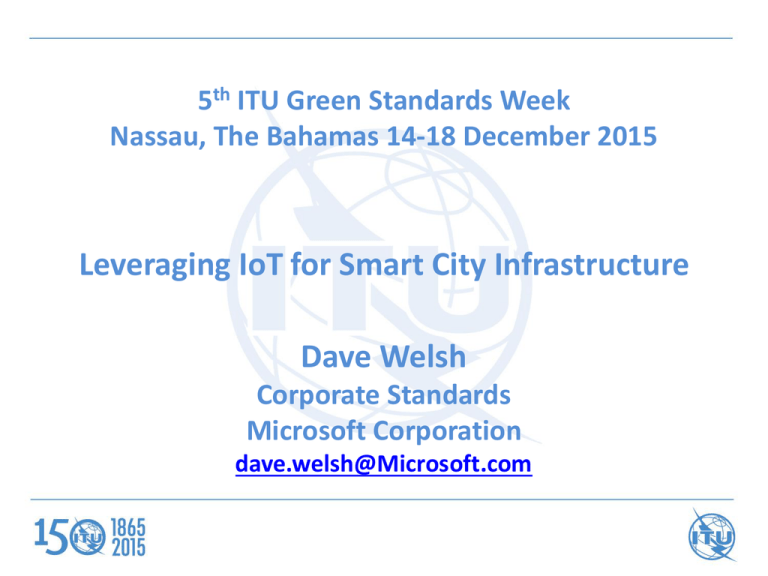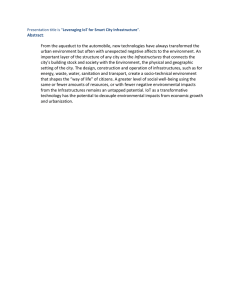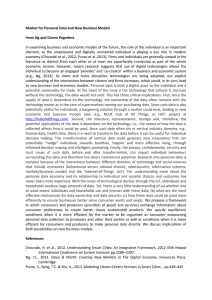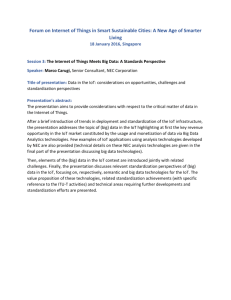Leveraging IoT for Smart City Infrastructure Dave Welsh
advertisement

5th ITU Green Standards Week Nassau, The Bahamas 14-18 December 2015 Leveraging IoT for Smart City Infrastructure Dave Welsh Corporate Standards Microsoft Corporation dave.welsh@Microsoft.com “Eye Chart” of IoT Opportunities Hype & Maturity with Transformative Technologies o Hype Cycle pattern suggests IoT related disillusionment / buzzword fatigue in the near future. o Consumer applications currently capture the IoT imagination and media attention. Market Adoption (2020) o Mature IoT scenarios already exist (e.g. connected banking ATMs). o By 2020, several IoT categories will have reached the steep part of the adoption s-curve, but the market as a whole will be on only the cusp of the transformative change induced by IoT. o Most IoT opportunities will emerge after 2020. o IoT enabled LEDs (90% consumer, 10% commercial & street lightning) will be a short term driver: significant energy savings (government encourage). o While IoT might be considered evolutionary from a technical point of view, it will enable many revolutionary and disruptive business models and services. Several IoT Scenarios (e.g. LED street lighting) IoT market as a whole IoT for City Level Decoupling (from urban development with environmental impact) • • • • Cities are complex networks of interlocked infrastructures that represent a web of interaction. The reconfiguration of urban infrastructures requires an understanding of the urban metabolism ”Material Flow Analysis” https://en.wikipedia.org/wiki/Material_flow_analysis but on a city scale See http://www.unep.org/resourcepanel/Publications/City-LevelDecoupling/tabid/106135/Default.aspx Sensors for Urban Infrastructure (from Smart Devices to Big Data Analytics) Towards Self Sufficient City Districts What Autonomous Vehicles See Setting Expectations for Cities (Change usually starts at the top) 1. 2. 3. 4. For example: “The 4 Commandments for Cities” A city of the future has to be environmentally Mayor Eduardo Paes, Rio de Janeiro (Brazil) friendly “Every time you see concrete jungle you must find open spaces. And when you find open spaces, make it so people can get to them” A city of the future has to deal with mobility and integration of its people “cities are packed with people, which means that high-capacity transportation is critically important” A city of the future has to be socially integrated “you can change the vicious circle to a virtuous one if you bring education, health–and open spaces–into the favelas” A city of the future has to use technology to be present “The city of the future is a city that cares about its citizens and integrates its citizens” http://www.ted.com/talks/eduardo_paes_the_4_commandments_of_cities Creating an Environment for IoT Success (New Public - Private Partnership Models) • Environmental sustainability needs to be effectively mainstreamed in urban development policy frameworks • Public investments should support infrastructure that stimulate low-carbon, resource-efficient and equitable urban development • Cities should set specific targets to use resources more efficiently and formulate plans to achieve them • Relevant micro and city level innovations need to be actively supported and networked • Private sector need to be engaged in translating proven innovations into citywide projects. We Live in a World of Cities






